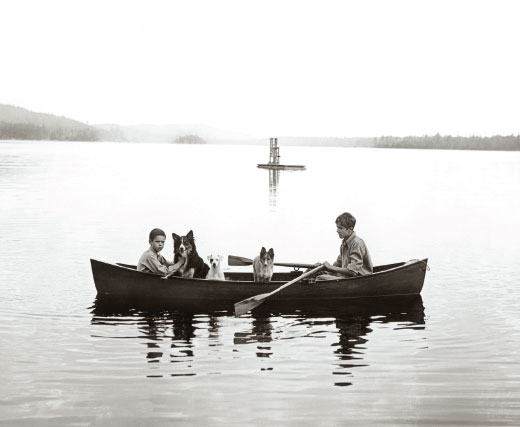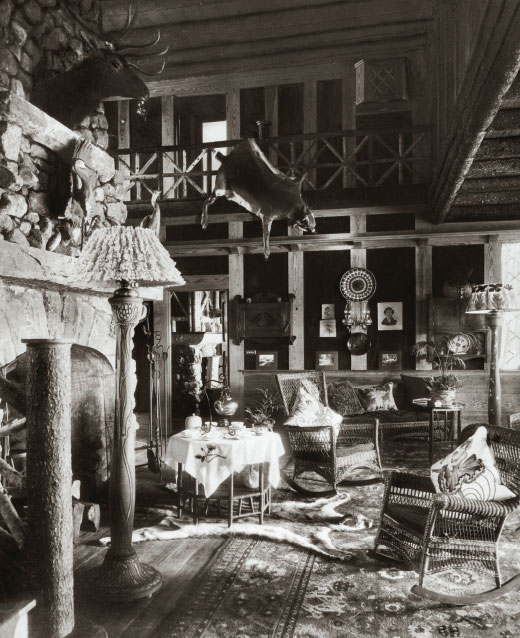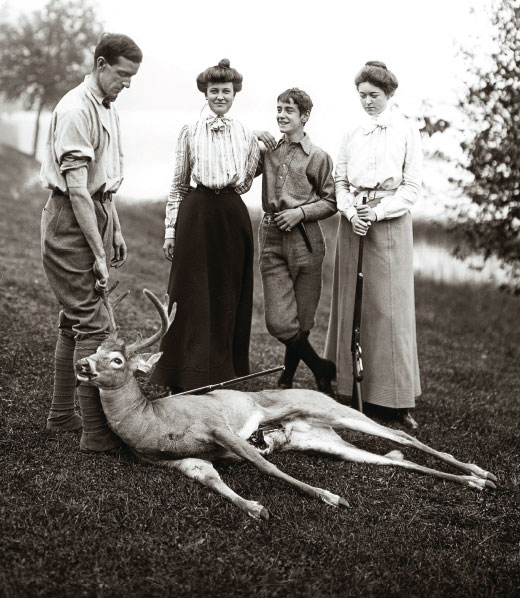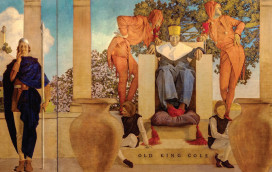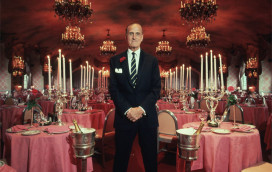Squeezed between Vermont and Canada in the north-easternmost corner of Upper New York State lie the wild, remote Adirondack Mountains. At first sight it is an uninhabited wilderness; on closer inspection you will find, nestling by myriad lakes and folded into the hills, some of the most spectacular vacation homes ever seen in North America. These are the so-called “camps” and “lodges” built by the steel, oil and fur tycoons of the late 19th and early 20th century, among them the names of the great families who formed America’s first aristocracy. Except they were hardly “camps” in the true sense of the word, but rather luxurious feats of rustic architecture, which have been documented in Gladys Montgomery’s book An Elegant Wilderness, a fascinating history in sepia that celebrates an extraordinary period in American life when moneyed New York sought to reconnect with nature.
Bluff Point, for example, on Raquette Lake, was home to Sara Stewart Van Alen, a descendant of the mighty Astor family. Although built in rural-backwoods style, within these vast log cabins there existed the height of urban luxury. Bluff Point had its own bowling alley, boat launch, clubhouse, a separate dining tent of gaily striped canvas and a network of covered walkways and bridges leading to an island gazebo. Playing at “country” by no means meant roughing it. Few of these gilded pleasure houses are still in private hands, but those days of high luxury with an Astor connection live on in the St. Regis Hotel on Fifth Avenue, a few blocks from Central Park – the city’s own patch of wilderness. A splendid Beaux-Arts hotel built by John Jacob Astor IV in 1904, its name was borrowed, at his niece’s suggestion, from Upper St. Regis Lake – an idyllic spot popular among the vacationing Astors and their wealthy circle.
By the turn of the 20th century, the Adirondacks had become a playground for America’s aristocrats of the eastern seaboard. Easily accessible from the fleshpots of New York for a weekend round trip, this wilderness was where the Gatsbys of the Gilded Age acted out the plutocrat’s version of the simple life. With their luxury timber cabins and secluded lakeside villas, they fished, sailed, walked, shot deer, painted, played tennis and golf and acted in amateur dramatics. It all made for a country-club set in genuine wild country. And what a vast country club it was. The Adirondack Park, where most of the camps and lodges were to be found, is around six million acres – bigger than Yosemite, Glacier, Everglades and Yellowstone national parks combined, claiming more than a hundred peaks.
Among the members of this wilderness club were the leading families of the day: the Roosevelts, Vanderbilts, Cabots, Guggenheims, Astors and others. The Astors were the most famous of all. Descendants of 18th-century German immigrants, they made their vast fortune out of fur trading. In a strange accident of fortune, many of the beavers that had died in the name of the Astor millions were, in fact, caught in the Adirondacks. The Astors then turned to property speculation, earning the moniker “the landlords of New York”, lending their name to the Waldorf-Astoria Hotel and the neighborhood of Astoria in Queens.(When John Jacob Astor IV went down with the RMS Titanic in 1912, he was the richest man aboard.) As the Astors and the other elite dynasties took up residence in their Adirondacks homes, they opted for a more rural-looking chic. The log cabins they slept in had a fine pedigree. Eight presidents, including Abraham Lincoln, had been born in log cabins, albeit more rugged ones than the superluxe Adirondacks versions that later came into vogue. At the 1876 Centennial Exposition of Arts and Manufacture in Philadelphia, the Swiss chalet had been a big hit. Soon afterwards, the Swiss chalet and log cabin became fashionable styles for homes in resorts, from the national parks of the west to the Adirondacks in the east.
Architectural elements that had originally been purely pragmatic – porches, screens, natural materials, gables and bays – became must-haves for the new millionaires. Particularly fancy owners, such as the Connecticut governor Phineas C. Lounsbury at his Echo Point Villa on Raquette Lake, had the names of their villas picked out in twig work on their front porches. Distinguished architects, such as Andrew Jackson Downing and Alexander Jackson Davis, published sought-after designs for weekend retreats, from cozy cottages to rustic British country houses. Ultra-luxe campsites were built, too, imitating the layout of Civil War military camps, but without the tough lifestyle.
The push towards the New York country weekend had been sparked by the 1869 publication of Adventures in the Adirondacks, by the Reverend William Henry Harrison Murray. Reverend Murray sang the praises of the free and open wilds to a new generation of tourists with enough time and money on their hands to explore the countryside on their doorstep. Already the Hudson River School of artists had enshrined the beauty of the land lying north of New York City, a few days’ journey up the Hudson River. In 1837, the founder of the school, Thomas Cole, visited Schroon Lake in the Adirondacks. In the same year, the painter Charles C. Ingham accompanied the geologist Ebenezer Emmons on New York State’s first-ever natural-history survey, when he came up with the name Adirondack, taken from the Iroquois word for the Algonquin Indians.
The Adirondacks became the hot destination for aspiring wilderness artists – among them the ladies of the Horicon Sketching Club, a group of well-heeled Manhattan women who canoed across the lakes to find the most picturesque vistas. They painted in broad bonnets and immaculate white cotton dresses, their packed lunches carried in wicker “Adirondack baskets” by robust guides. Then, in 1871, Dr. Thomas C. Durant of the Union Pacific Railroad completed the line to the Adirondacks – or “a Central Park for the world”, as the New York Times called it, now that it was so easily reachable from Manhattan. America’s first accessible wilderness was open for business – with perfect timing. Just as industrialization was roaring across the nation, ripping open the landscape for mining, despoiling it with mills, chimneys and factories, so Americans woke up to the romance of their disappearing countryside. The Adirondacks were under particular threat as they were progressively stripped for their timber. However, in 1894, the park was granted state constitutional protection, ensuring that the territory would be “forever wild”. The lodge and camp owners were determined to preserve their holiday retreats, setting up the Association for the Preservation of the Adirondacks in 1901.
This new class of tycoons certainly had money to burn. In 1892, the New York Tribune published a list of 4,047 American millionaires, a large chunk of them in New York, their fortunes founded in steel, railways, oil and textiles. The story of these princes of the American Renaissance are the subject of a new NBC series, The Gilded Age, written by the creator of the British period drama Downton Abbey, Julian Fellowes. The Gilded Age refers to the title of an 1873 novel by Mark Twain and Charles Dudley Warner, who both vacationed in the Adirondacks. They, in turn, borrowed the expression from Shakespeare’s King John:
“To gild refined gold, to paint the lily...
Is wasteful and ridiculous excess.”
The gazillionaires may have played up to the simple life, but their behavior was dictated by codes as strict as those that ruled their weekdays in the city. In her 1923 book on etiquette, Emily Post wrote a chapter on the Adirondacks house party: “Let no one think that this is a ‘simple’ (by that meaning either easy or inexpensive) form of entertainment. ‘Roughing it’ in the fashionable world (on the Atlantic coast) is rather suggestive of the dairymaid playing of Marie Antoinette; the ‘rough’ part being mostly ‘picturesque effect’ with little taste for actual discomfort.” For these brief spells in the country, the new rich pretended to defer to a new order where country skills outranked wealth and position. The poet Ralph Waldo Emerson lampooned the idea:
“Look to yourselves, you polished gentlemen!
No city airs or arts pass current here
Your rank is all reversed; let men of cloth
Bow to the stalwart churls in overalls;
They are the doctors of the wilderness,
And we the low-prized laymen.”
Of course, this was all an illusion. The kings of Wall Street guarded their country retreats as jealously as they did their Fifth Avenue palazzi. At the entrance to Camp Uncas there was a forbidding sign saying: “Private Park. All trespassing hereon is hereby forbidden under penalty of the law. J. Pierpoint Morgan. Owner.” Morgan was the banker and art collector behind J.P. Morgan bank and the Morgan Library in New York. But it wasn’t all log cabins for the deep-pocketed. Some wanted to live like their European counterparts in vast, stately homes. Grander cabins were fitted with stained-glass windows, antler chandeliers, Moroccan wall hangings, Gothic Revival roofs and Mock Tudor paneling. The Wild Air cabin on Upper St. Regis Lake, built in 1882 for Ella Spencer Reid, the niece of the publisher of the New York Tribune, had its own billiards room. At Bull Point Lodge on Upper Saranac Lake, the banker Otto Kahn had two billiard tables.
At Litchfield Park, Edwin Litchfield built up one of the best-stocked hunting estates in America, wrapped around a château in the French regal style found at Fontainebleau and Chambord. Often, however, the urban incomers weren’t much good at the country sports they idolized. Between 1898 and 1900, three guides were shot dead by clueless weekenders who’d mistaken them for deer and bears.
At Sagamore, the Vanderbilts holidayed in a “Swiss chalet” the size of a schloss, with its own separate, free-standing dining hall. They got there from New York in a private Pullman car, the Wayfarer, finishing the journey in carriages drawn by four horses. In the evening, the dinner menu was printed in badly written French. But they were hardly slumming it with “huitres on the half shell, consommé Paelermo, Truite du Lac grillé m’d’hotel, Quartier de Venaison St. Hubert, and Poulets rotis, Salades Grape Fruit, Plum-Pudding and Patisserie.” They ate off silver and drank from glasses etched with the spruce logo of Sagamore. The lodges had to be vast, given the number of guests that these wealthy families often invited to stay. In the mid-1930s, the Garvans of Kamp Kill Kare invited the Yale and Harvard baseball teams for the weekend so that they could slug it out on the Garvans’ private diamond. They also had to accommodate an enormous staff. In 1903, at Knollwood on Lower Saranac Lake, the lawyer Louis Marshall employed 24 maids, chefs, grooms and butlers to maintain his simple “country cottage” lifestyle.
At Camp Inman, the boathouse was outfitted with its own casino, while on Upper St. Regis Lake, the Vanderbilts commissioned a huge, floating teahouse, a Japanese pagoda with swooping roofs supported by ornate, painted pillars. Inside, even modest cabins were decorated with Eastern touches – Japanese fans and parasols and Cantonese china were popular. Some weekenders took to wearing Chinese peasant hats as they paddled Indian canoes across Raquette Lake.
Taxidermy, too, was fashionable – stuffed water buffaloes, tigers, zebras, bears and bison populated the drawing rooms of the grander cabins. In the summer of 1926, President Calvin Coolidge stayed at White Pine on Osgood Pond, built in 1913 for half a million dollars for Archibald White, the president of Ohio’s Columbia Gas & Electric Company. Time magazine reported how the President awoke to the sight of a portrait of the Emperor Napoleon, and heard “the soft voice of luxury speaking through French tapestries, Oriental rugs, Italian paintings, a Japanese pagoda, an alpine rock garden, a billiard cabin, a bowling alley, a grand piano, a personal telephone exchange and private house-movies.”It was these levels of luxury, comfort and modern conveniences that John Jacob Astor IV determined to bring back to Manhattan for his new hotel. As the 20th century progressed, Astor’s fellow Adirondacks holidaymakers also headed back to the city, for good. For many, it was no longer practical to pour money into maintaining these beautiful but sprawling country piles. As the dynastic heirs repaired to their Park Avenue palazzi, their old holiday homes were neglected.
The state’s constitutional pledge to keep the Adirondacks “forever wild” seemed at odds with the preservation of these grand weekend cottages. Nehasane, the elaborate camp of Lila Vanderbilt Webb and William Seward, was even destroyed by the state in keeping with the wilderness sentiment. In recent years, that attitude has changed, and the camps and lodges are increasingly seen as an integral part of the Adirondacks landscape. Today, a tiny number of survivors remain as family retreats, the way they were intended to be. Others have become university teaching facilities, homeowner associations, non-profit educational institutions, destination lodgings and country clubs. The camps and lodges of the Adirondacks may have only had a brief flowering period of 80-odd years, but they left a continuing, living legacy in the form of The St. Regis New York. The grand hotel was the last word in turn-of-the-century glamour, and rapidly became the drawing room of choice for the emerging tycoon dynasties of Manhattan, before the horrors of the First World War, the Great Crash of 1929 and the Depression which followed it brought this golden age to an end. But to this day it is that legacy of life as lived by a new American aristocracy – of the Astors and Rockefellers, Vanderbilts and Carnegies – that gives The St. Regis New York the air of the most luxurious of private homes.
An Elegant Wilderness: Great Camps and Grand Lodges of the Adirondacks 1855-1935 by Gladys Montgomery is published by Acanthus Press, $75.
